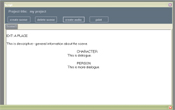SCREENWRITING
Why Worry about Words and Pictures?
Screenwriting provides the foundation for movie production in all kinds of contexts, for cinema films and tv programmes, for documentaries and tv commercials, for animation and business television. Traditional scripts, however, constrain the writer's freedom to link sounds and images with dialogue and to elaborate those ideas, while they are actually at work on the script. The writer may well have crystal clear concepts about visualisation, but these are inevitably obscured in written form. Other members of the production team cannot see the writer's visual ideas in a traditional script.
Screenwriters are often explicitly constrained from including visuals in their scripts and are expected to concentrate on story and dialogue. For more than a century, there has been a powerful distinction within the industry between writers and directors, creating a barrier between the twinned tasks of writing dialogue and visualisation as movie projects are developed. During the early decades of silent film, writers provided stories for film-makers and were rarely involved in production. Even pioneer screen-writers, including talents such as Anita Loos and Elinor Glyn, either moved towards directing (Glyn), or concentrated on writing (Loos). Now, there are thousands of writers who direct and directors who write, while many more are training to become both writers and directors for all different kinds of production. More importantly, there are now innumerable production situations where the director is expected to write and writers are called on to direct.
The traditional written script is a pretty inflexible kind of document, especially if we try to ask ourselves what kind of movie will be made from it. Scripts are not only difficult to write, they are difficult to read. The honest appraisal of any traditional script is 'OK, so far' for story and dialogue, but everyone involved knows that this is only a provisional phase in the creation of a film.
Movies involve the articulation of images and sounds in time and the written script has none of these qualities. Scripts include only passing references to images, the dialogue must be read and, typically, there will only be broad generalisations about the duration of any scene. This makes it extremely difficult to judge atmosphere, balance and pace. It is a real challenge to judge the style of a finished movie from a traditional script. Perhaps this is one of the reasons why the industry depends so much on genre, or established formats, because everyone involved has a pretty good idea of what to anticipate and that helps them judge what they are reading.
For projects that are strongly visual, creating a storyboard and animatic is the next logical requirement, but creating a storyboard from a completed script implies the writer's work is done and begins to distance the writer from the subsequent production, part of the gradual process of passing responsibility for the movie from writer to director, but this shift of responsibility is often premature for projects in development.
Judging scripts is an issue that producers and script readers deal with on a daily basis, but the massive increase in different kinds of production means there are many many more people who are asked to approve scripts. They might include people in management, technical and legal departments, who are asked to 'sign off' the 'contents' of a production for their business. They might include executives in marketing and advertising agencies, or their clients, who want to integrate film and video successfully in campaigns. They might include colloborators and partners in independent productions.
The debate about screen-writing should involve every-one who works with scripts, not only writers and directors, but also script-readers and producers, all those involved in the commissioning and funding process. Developing movies is both about creativity and finding answers to a host of practical questions.
The BPC-Screenplay Forums are intended for discussions around the creative issues of writing for the screen and the practical aspects of development. We have our own ideas about enhancing the development process, but we would be pleased to see contributions from script-readers, film-funding organisations, advertising agencies, tutors and trainers, agents and producers, as well as everyone who writes and directs.

Developing Projects for Professional Production.
Enabling scriptwriters and writer directors to watch their movie as an animatic, while they write the script.

Evolution for Scriptwriting
email: contact@berlinpicturecompany.com.